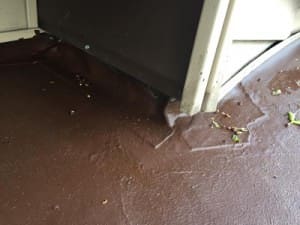Flat roofs have created problems for many homeowners and business owners alike for as long as low slope roofs have been around, but the materials have changed and they’re changing again.
The old mop, tar and pebble roofs gave way to rubber and TPO (the white membrane you see on many commercial buildings). Elastomeric membranes, discussed later in this article, are coming on strong.
Still, black rubber, known to contractors as EPDM, is king these days for flat roofs. Some contractors are using the 45 mil which is really insufficient although it is typically what you’ll find in the DIY stores. Opt instead for the 60 mil and make sure your contractor is using the proper thickness. Lighter thickness rubbers are still sufficient and appropriate for gardening needs but you certainly don’t want to rely on them to protect your home.
What is under the rubber is just as important as the rubber itself. For larger areas (wider than 20 feet) you’ll want to make sure that your contractor is making sure that there is a slight slope to your surface. This is accomplished by using tapered foam. On top of the foam is a fibrous board which comes in 4′ x 8′ sheets and is secured with screws which anchor down with the aid of plates (think big washers under the screw heads). Then rubber is then glued to the fibrous board and secured along the edges on what is optimally a vertical surface due to an overhanging of the rubber, with t-bars, also known as termination bars. Roofs that are wider than 20′ must be seamed together, which is yet another process wrought with potential dangers.
If that all sounds like quite the process, it is. There are plenty of ways to screw this up and hiring a professional is still the best option. Even slight deviations from proper installation can be disasters waiting to happen.
There is a great option now available to most contractors that can help the pro-active homeowner. If your roof hasn’t yet failed, consider adding an elastomeric membrane to seal the whole thing up and extend the life of your roof for 10 to 50 years. Elastomeric membranes can be added on top of many products including metal (tin or copper are common) or EPDM among a long list of other types of flat roofing.
Elastomeric membranes come in liquid form and can be applied similar to paint, but with a series of brushes, rollers and squeegees. Applying it in optimal temperature and weather conditions is recommended, but not absolutely required.
But here’s the thing — this stuff is awesome. If your roof hasn’t already failed, you can effectively clean it, cover it and get another 50 years out of it. If you’ve waited until your EPDM has already failed so that you will be trapping moisture under it, then you need to go the route of replacement of the EPDM and all of the underlayments.
One of the leading elastomeric manufacturers markets their product by painting the inside of a cardboard box with this stuff, filling their displays with water, and floating a rubber duck in the box. It’s nothing short of amazing.
The other great thing about this type of product is that there are no seams to leak — seams being the bane of rubber roofs. Regardless of the size of your roof, elastomeric membranes can make a roof seamless. Even if your roof is not properly sloped, you can still keep water out, even if there is a significant ponding effect.


